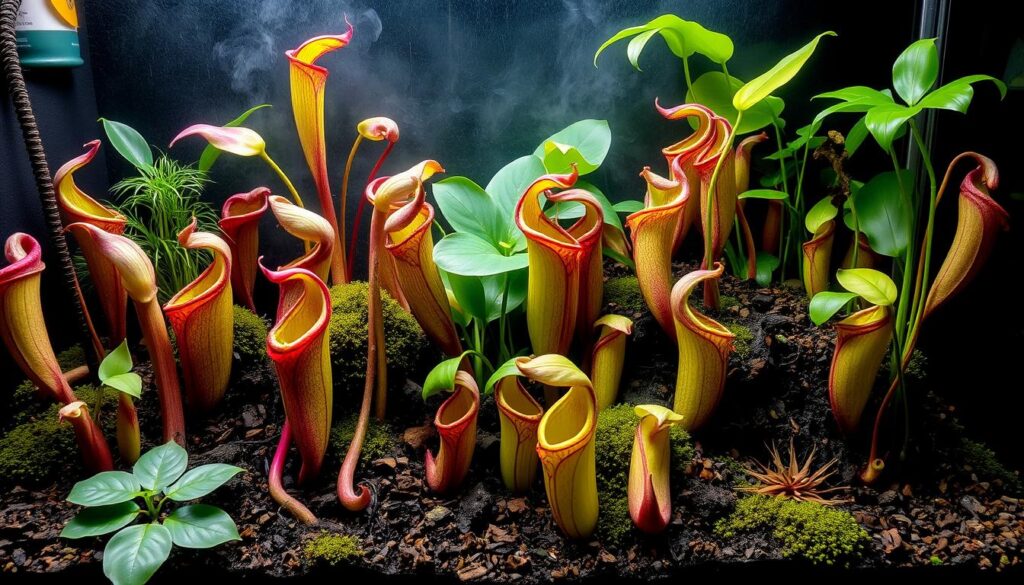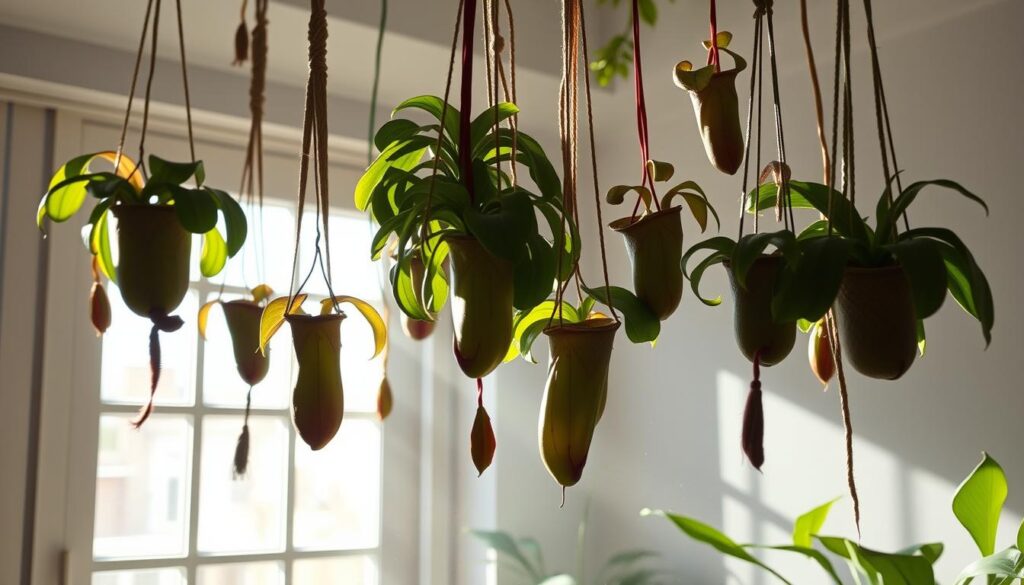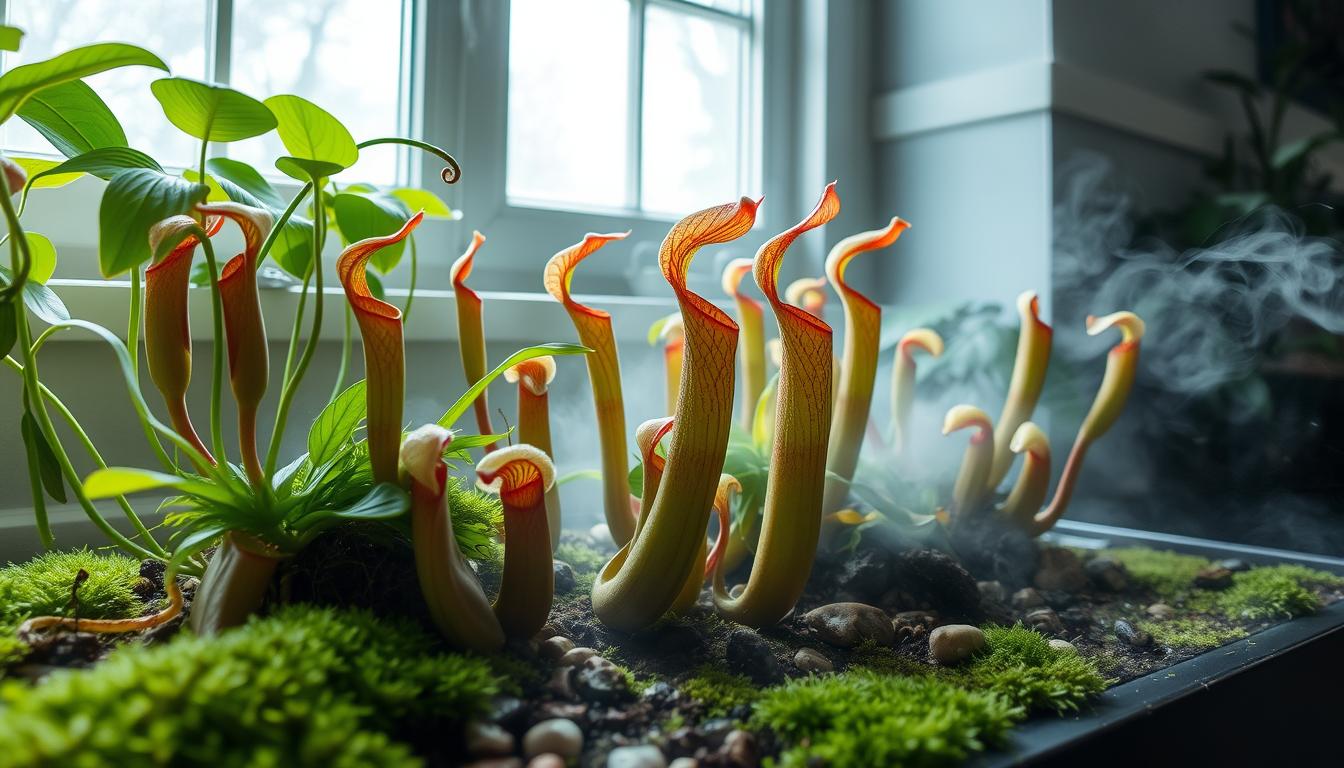Caring for a pitcher plant is a unique and rewarding experience. It requires specific knowledge of carnivorous pitcher plant care. Understanding the plant’s needs is key, including high humidity and specific watering requirements. Many people wonder, can you keep a pitcher plant indoors? Yes, but it demands attention to detail and a commitment to providing the right conditions.
Pitcher plants are relatively hard to care for due to their unique requirements. But with the right guidance, anyone can become a successful pitcher plant caregiver.
When caring for a pitcher plant, it’s important to know they don’t necessarily need bugs to survive. But bugs can be a nutrient source. Pitcher plants, belonging to the genus Nepenthes, can have traps that exceed a diameter of 15 cm. They thrive in high humidity, requiring around 50-70% relative humidity for optimal growth.
To thrive, Sarracenia requires at least six hours of direct sunlight daily. This is vital for their growth. Consistent moisture is also key, and the soil should be kept damp but not waterlogged.
Pitcher plant care is a delicate balance of providing the right environment, nutrients, and attention. By understanding the unique requirements of these plants, gardeners and plant enthusiasts can enjoy the rewards of caring for a pitcher plant. Whether you’re a seasoned gardener or just starting out, this guide will provide you with the necessary knowledge to become a successful pitcher plant caregiver. From understanding the basics of carnivorous pitcher plant care to mastering the art of caring for a pitcher plant, this guide has got you covered.
Table of Contents
Understanding Pitcher Plant Basics and Difficulty Level
Pitcher plants are special because they get nutrients by eating insects. They are found in North America, like the American pitcher plant. To grow them indoors, you need to know their specific needs.
Brown leaves on pitcher plants often mean they’re not getting enough water or too much. To keep them happy, mimic their natural home. This means the right light, water, and nutrients. Caring for an American pitcher plant requires careful attention and the right conditions.
Types of Pitcher Plants for Indoor Growing
Many pitcher plants can grow indoors, like Nepenthes and Sarracenia. They are easy to care for and can do well in different settings. It’s important to give them the right light and water. Caring for them indoors means finding the perfect balance of nutrients and moisture.
Basic Care Requirements Overview
To keep your pitcher plant healthy, you need to provide the right environment. This includes:
- Providing the right amount of light, which can range from bright indirect light to full sun
- Watering with distilled or rainwater, as tap water can contain too many minerals
- Fertilizing with live insects or a balanced fertilizer designed for carnivorous plants
Ideal Growing Conditions
Pitcher plants love warm temperatures and high humidity. This makes them perfect for greenhouses or indoor spaces. American pitcher plants need a temperature of 65-85°F (18-30°C) and humidity of 40-60%. With the right care, you can enjoy their unique beauty indoors.
Essential Carnivorous Pitcher Plant Care Guidelines
Understanding your pitcher plant’s needs is key in carnivorous plant care. Many wonder if they should put water in the pitcher. But, it’s best not to, as it can cause rot and other issues. Instead, focus on keeping the air around it humid, which is vital for how to take care of a pitcher plant.
A pitcher plant care guide suggests keeping the saucer’s water level at about 1/4 inch. Refill it when it’s almost dry. The soil mix should be equal parts sphagnum peat moss and horticultural sand. Also, ensure it gets 12-14 hours of light, whether from the sun or special plant growth tubes.
Important tips for carnivorous plant care include:
* Use distilled or rainwater to prevent mineral buildup
* Keep humidity high, like in a bog
* Give the right light, less in winter
* Don’t overwater to avoid rot
By following these tips and knowing your pitcher plant’s needs, you can create a great environment. This will help your pitcher plant care thrive and enjoy the unique benefits of these plants.
Water and Feeding Requirements for Healthy Growth
To keep a pitcher plant happy and thriving, it’s essential to understand its water and feeding requirements. Caring for carnivorous plants means giving them the right moisture and nutrients. Pitcher plants need at least six hours of direct sunlight daily, which is part of their pitcher plant light requirements. They also prefer moist, nitrogen-rich, and well-draining soil, similar to their natural habitats, which is key for common swamp pitcher plant care.
Proper watering techniques are vital. The soil should be consistently moist but not waterlogged. Using mineral-free water sources like rainwater or distilled water can help prevent mineral buildup. For caring for carnivorous plants, it’s recommended to water them when the soil volume is approximately 25 percent dry, indicating a specific moisture threshold for consistent health.

Proper Watering Techniques
- Use mineral-free water to prevent mineral buildup.
- Water when the soil is 25 percent dry.
- Avoid overwatering, which can lead to root rot.
Natural and Supplemental Feeding Methods
Pitcher plants are carnivorous, obtaining essential nutrients by capturing insects. Supplemental feeding can also be beneficial. A few insects per month can provide the necessary nutrients without the need for additional fertilizers, aligning with the pitcher plant light requirements and caring for carnivorous plants principles.
| Feeding Method | Description |
|---|---|
| Natural Feeding | Capturing insects for nutrients. |
| Supplemental Feeding | Providing additional insects for nutrition. |
Preventing and Addressing Common Problems
When caring for carnivorous plants indoors, brown leaves are a common problem. They can be caused by wrong watering, not enough light, or lacking nutrients. To avoid this, keep the right pitcher plant temperature and humidity. Aim for humidity above 60 percent, which helps with pitcher growth.
For mini pitcher plants, finding the cause of brown leaves is key. It might be too much or too little water, or too much sunlight. Try changing the watering, adding shade, or using a humidifier. For more help, check out carnivorous plant care online.
Here are some common problems and their solutions:
- Brown leaves: Check the watering schedule, humidity level, and light exposure.
- Slow growth: Ensure the plant is receiving enough nutrients, water, and light.
- Pest problems: Inspect the plant regularly and treat any infestations promptly.

By following these tips, you can avoid common issues and keep your pitcher plant healthy. Always research your plant’s specific needs. If unsure, don’t hesitate to ask experts about carnivorous plant care indoor.
| Problem | Cause | Solution |
|---|---|---|
| Brown leaves | Overwatering, underwatering, or insufficient humidity | Adjust watering schedule, provide more shade, or use a humidifier |
| Slow growth | Inadequate nutrients, water, or light | Ensure proper fertilization, watering, and lighting |
Maintenance and Pruning Techniques
For the best care of hanging pitcher plants, knowing how to plant and care for them is key. Regular upkeep and pruning are vital for their health and look. Pruning boosts vigor and makes the plant fuller, but it should be done carefully.
Pruning involves removing dead pitchers and leaves to keep the plant healthy and looking good. Cut off dead leaves at the stem base. For yellow leaves, trim just below the yellow part to keep green leaves. Severe pruning is okay for old, neglected plants to encourage new growth. But, never cut off more than one-third of the plant at once.

Trimming green vine stems helps side shoots grow. Prune Tropical Pitcher Plants in late winter or early spring, just before they grow. They need bright, indirect light, not direct sunlight, to avoid damage. By following these tips, gardeners can help their pitcher plants flourish, whether they’re hanging or in pots.
| Plant Type | Pruning Frequency | Pruning Time |
|---|---|---|
| Tropical Pitcher Plants | Less frequent during winter months | Late winter or early spring |
| Nepenthes | As needed, avoiding growth and flowering periods | Aligned with the plant’s growth cycle |
Mastering Long-Term Pitcher Plant Success
With the right care, pitcher plants can live indoors for years. Follow the growing conditions and maintenance tips in this guide. This way, your American pitcher plants will keep on impressing and growing.
It’s key to water and feed your plants right. Make sure to check the soil moisture often. Don’t overwater, as it can cause root rot. Also, give them extra food during the growing season to help them grow strong.
Learning to care for pitcher plants takes time and effort. But with the right light, temperature, and humidity, they’ll do great. Enjoy watching these amazing indoor carnivores and the beauty they add to your home.
Frequently Asked Question
How hard is it to keep a pitcher plant alive?
Pitcher plants are fairly easy to care for once you understand their needs. They thrive in bright, indirect light, consistently moist soil, and high humidity. As long as you use the right type of water (distilled or rainwater) and maintain proper conditions, they can flourish indoors or outdoors.
Should I cut the dead pitchers off my pitcher plant?
Yes, cutting off dead pitchers is a good idea. It keeps the plant looking tidy and allows it to focus its energy on growing new, healthy pitchers. Use sterilized scissors and cut at the base of the dead pitcher to avoid damaging the plant.
How to keep carnivorous plants indoors?
To keep carnivorous plants indoors, place them in a spot with bright, indirect sunlight or use grow lights if natural light is limited. Keep the soil moist with distilled or rainwater and maintain a humid environment by misting the plant or using a humidity tray. Avoid fertilizing them with traditional plant food—they prefer to catch their nutrients from insects.
Do pitcher plants need bugs to survive?
Pitcher plants don’t absolutely need bugs to survive, but catching insects provides essential nutrients that help them grow faster and healthier. If they don’t catch bugs regularly, they can still survive as long as their other needs (light, water, humidity) are met.
How do I make my pitcher plant happy?
Provide your pitcher plant with plenty of bright, indirect sunlight, high humidity, and consistently moist soil. Use distilled or rainwater to prevent mineral buildup, and occasionally feed it small insects if it’s not catching any on its own. Happy pitcher plants produce vibrant, healthy pitchers!
Can I feed dead bugs to my pitcher plant?
Yes, you can feed your pitcher plant dead bugs, but make sure they’re small enough to fit easily inside the pitchers. Avoid feeding too many at once to prevent rotting, and don’t feed it processed or salted insects.

